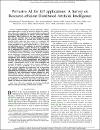Pervasive AI for IoT applications: A Survey on Resource-efficient Distributed Artificial Intelligence
| المؤلف | Baccour, Emna |
| المؤلف | Mhaisen, Naram |
| المؤلف | Abdellatif, Alaa Awad |
| المؤلف | Erbad, Aiman |
| المؤلف | Mohamed, Amr |
| المؤلف | Hamdi, Mounir |
| المؤلف | Guizani, Mohsen |
| تاريخ الإتاحة | 2022-10-12T08:26:48Z |
| تاريخ النشر | 2022-01-01 |
| اسم المنشور | IEEE Communications Surveys and Tutorials |
| المعرّف | http://dx.doi.org/10.1109/COMST.2022.3200740 |
| الاقتباس | Baccour, E., Mhaisen, N., Abdellatif, A. A., Erbad, A., Mohamed, A., Hamdi, M., & Guizani, M. (2022). Pervasive AI for IoT applications: A Survey on Resource-efficient Distributed Artificial Intelligence. IEEE Communications Surveys & Tutorials. |
| الملخص | Artificial intelligence (AI) has witnessed a substantial breakthrough in a variety of Internet of Things (IoT) applications and services, spanning from recommendation systems and speech processing applications to robotics control and military surveillance. This is driven by the easier access to sensory data and the enormous scale of pervasive/ubiquitous devices that generate zettabytes of real-time data streams. Designing accurate models using such data streams, to revolutionize the decision-taking process, inaugurates pervasive computing as a worthy paradigm for a better quality-of-life (e.g., smart homes and self-driving cars.). The confluence of pervasive computing and artificial intelligence, namely Pervasive AI, expanded the role of ubiquitous IoT systems from mainly data collection to executing distributed computations with a promising alternative to centralized learning, presenting various challenges, including privacy and latency requirements. In this context, an intelligent resource scheduling should be envisaged among IoT devices (e.g., smartphones, smart vehicles) and infrastructure (e.g., edge nodes and base stations) to avoid communication and computation overheads and ensure maximum performance. In this paper, we conduct a comprehensive survey of the recent techniques and strategies developed to overcome these resource challenges in pervasive AI systems. Specifically, we first present an overview of the pervasive computing, its architecture, and its intersection with artificial intelligence. We then review the background, applications and performance metrics of AI, particularly Deep Learning (DL) and reinforcement learning, running in a ubiquitous system. Next, we provide a deep literature review of communication-efficient techniques, from both algorithmic and system perspectives, of distributed training and inference across the combination of IoT devices, edge devices and cloud servers. Finally, we discuss our future vision and research challenges. |
| اللغة | en |
| الناشر | Institute of Electrical and Electronics Engineers Inc. |
| الموضوع | Artificial intelligence Computational modeling Data models deep learning distributed inference federated learning Internet of Things Pervasive computing reinforcement learning Servers Task analysis Training |
| النوع | Article |
الملفات في هذه التسجيلة
هذه التسجيلة تظهر في المجموعات التالية
-
علوم وهندسة الحاسب [2491 items ]


